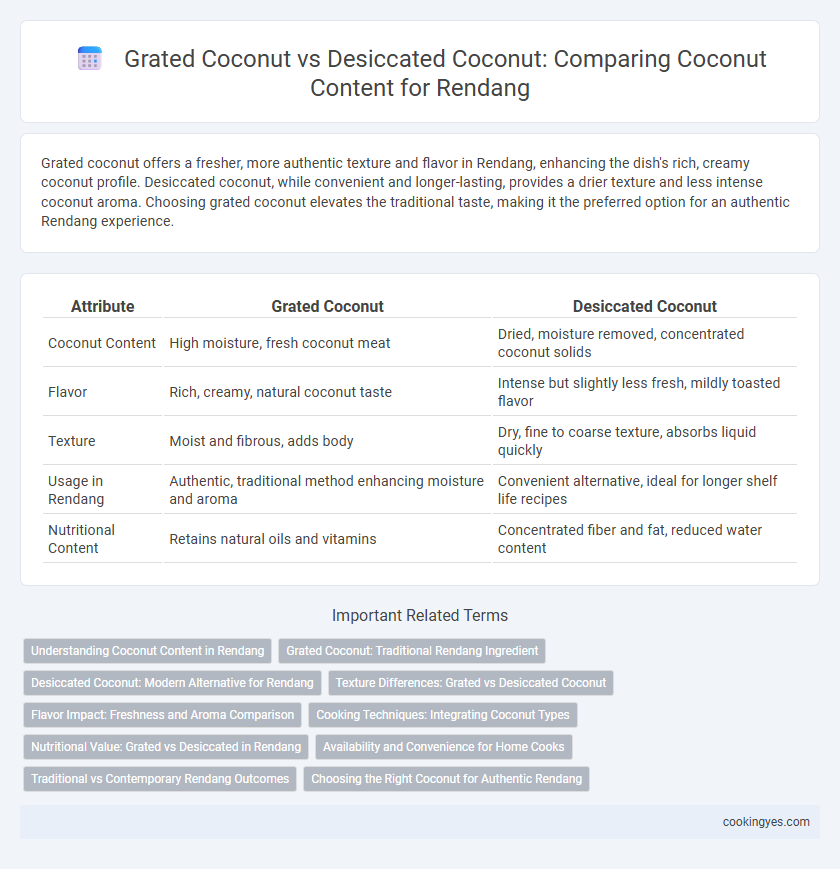Grated coconut offers a fresher, more authentic texture and flavor in Rendang, enhancing the dish's rich, creamy coconut profile. Desiccated coconut, while convenient and longer-lasting, provides a drier texture and less intense coconut aroma. Choosing grated coconut elevates the traditional taste, making it the preferred option for an authentic Rendang experience.
Table of Comparison
| Attribute | Grated Coconut | Desiccated Coconut |
|---|---|---|
| Coconut Content | High moisture, fresh coconut meat | Dried, moisture removed, concentrated coconut solids |
| Flavor | Rich, creamy, natural coconut taste | Intense but slightly less fresh, mildly toasted flavor |
| Texture | Moist and fibrous, adds body | Dry, fine to coarse texture, absorbs liquid quickly |
| Usage in Rendang | Authentic, traditional method enhancing moisture and aroma | Convenient alternative, ideal for longer shelf life recipes |
| Nutritional Content | Retains natural oils and vitamins | Concentrated fiber and fat, reduced water content |
Understanding Coconut Content in Rendang
Grated coconut and desiccated coconut differ significantly in moisture content and texture, impacting the authenticity and flavor profile of rendang. Grated coconut, freshly shredded from mature coconuts, retains higher moisture and natural oils essential for the rich, creamy consistency traditional to rendang. Desiccated coconut, being dried and processed, lacks these oils and moisture, resulting in a drier texture and less intense coconut flavor that can alter the dish's characteristic depth and mouthfeel.
Grated Coconut: Traditional Rendang Ingredient
Grated coconut is the preferred traditional ingredient in authentic Rendang recipes, offering a rich, fresh texture and natural oils that enhance the dish's depth and aroma. Unlike desiccated coconut, which is dried and processed, grated coconut retains moisture and essential fats, contributing to the creamy consistency and robust flavor profile characteristic of classic Minangkabau Rendang. Using freshly grated coconut ensures a more vibrant coconut content, essential for achieving the slow-cooked, tender meat and complex spice blend fundamental to genuine Rendang.
Desiccated Coconut: Modern Alternative for Rendang
Desiccated coconut serves as a convenient modern alternative to grated coconut in rendang recipes, offering a longer shelf life and consistent texture without compromising flavor. Its low moisture content helps maintain the rich, creamy coconut profile essential for authentic rendang, while simplifying preparation and storage. Using desiccated coconut enables cooks to achieve the traditional savory depth of rendang with greater ease and efficiency.
Texture Differences: Grated vs Desiccated Coconut
Grated coconut offers a moist, tender texture that enhances rendang's richness, while desiccated coconut provides a drier, coarser consistency that can alter the dish's mouthfeel. The natural oils retained in fresh grated coconut contribute to a creamier, more authentic rendang sauce compared to the dehydrated desiccated variant. Choosing grated coconut ensures a smoother, more luscious rendang texture, essential for capturing the dish's traditional depth and complexity.
Flavor Impact: Freshness and Aroma Comparison
Grated coconut, often used fresh, provides a rich, creamy texture and a more intense, natural coconut aroma essential for authentic rendang flavor. Desiccated coconut, while convenient, loses some moisture and volatile oils during drying, resulting in a milder aroma and less pronounced freshness. The use of freshly grated coconut enhances the dish's depth and complexity, contributing significantly to rendang's signature fragrant and creamy profile.
Cooking Techniques: Integrating Coconut Types
Grated coconut provides a fresher, richer coconut flavor and releases more natural oils during the slow-cooking process essential for authentic rendang, enhancing the dish's texture and depth. Desiccated coconut, being dried and shredded, absorbs liquids differently and may require rehydration to prevent a dry or grainy result while maintaining the signature coconut richness. Integrating grated coconut in the initial stages and a small amount of desiccated coconut later can balance moisture retention and intensify the coconut essence in rendang.
Nutritional Value: Grated vs Desiccated in Rendang
Grated coconut in rendang retains more natural moisture and nutrients such as healthy fats, vitamins C and E, and antioxidants, which contribute to a richer flavor and creamier texture. Desiccated coconut, while convenient and shelf-stable, often undergoes drying processes that reduce its water content and may diminish sensitive nutrients but still provides concentrated fiber and protein. Choosing grated coconut enhances the nutritional profile with fresher fats and micronutrients, whereas desiccated coconut offers a practical alternative with slightly lower nutrient density.
Availability and Convenience for Home Cooks
Grated coconut offers a fresh, authentic flavor ideal for traditional Rendang but may be less accessible in urban areas compared to desiccated coconut, which is widely available in supermarkets and has a longer shelf life. Desiccated coconut provides convenience for home cooks by eliminating the need for grating and drying fresh coconut, enabling quick preparation without compromising texture significantly. Availability of desiccated coconut makes it a practical choice for consistent coconut content in Rendang recipes, especially for those with limited access to fresh coconuts.
Traditional vs Contemporary Rendang Outcomes
Grated coconut, used traditionally in rendang, retains natural moisture and rich oils, contributing to a creamier texture and deeper flavor complexity essential for authentic slow-cooked rendang. Desiccated coconut, favored in contemporary rendang recipes for convenience, provides a drier, more concentrated coconut presence but can result in a less moist and slightly grainier texture. The choice between grated and desiccated coconut significantly impacts the coconut content's aroma, mouthfeel, and traditional authenticity in rendang outcomes.
Choosing the Right Coconut for Authentic Rendang
Grated coconut provides a fresh, rich flavor and moist texture essential for authentic Rendang, while desiccated coconut offers convenience but lacks the natural oils and creamy consistency. Using freshly grated coconut ensures the Rendang's sauce achieves its signature depth and aroma, crucial for traditional Indonesian taste. For an authentic Rendang experience, prioritize fresh grated coconut over desiccated varieties to enhance the dish's coconut content and overall richness.
Grated Coconut vs Desiccated Coconut for Coconut Content Infographic

 cookingyes.com
cookingyes.com